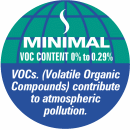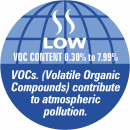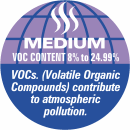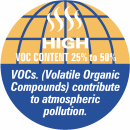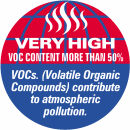Key practical differences
You will still get the same professional end finish you expect from Dulux Trade paints with excellent flow out of brush marks, great coverage and no compromise on the durability of the systems. The gloss systems will also stay glossier for longer. However, as regular users of these products you may notice a few differences whilst applying them.
Products affected
- Dulux Trade
- High Gloss, Undercoat, Eggshell, Satinwood, New Work Gloss and Undercoat
- Weathershield
- Weathershield Exterior High Gloss, Weathershield Exterior Flexible Undercoat
Extended drying time
With 25% less solvent and a higher solids content, new 2010 formulations form a slightly thicker layer.
The film will appear slightly 'cheesy' for longer than with 2007 products which will mean that when it is sanded before fully dry it will have an increased tendency to ball up and block the sand paper. When fully cured the film is slightly softer than a 2007 product, but not significantly. For an undercoat under standard drying conditions we would expect it to take up to 24 hours to through dry and be easy to sand, a top-coat may take slightly longer. This compares to about 16 hours for a 2007 product. ALL VOC 2010 compliant solvent-based trim paints (including Weathershield Exterior Undercoat) take 16-24 hours to dry.
Drying will obviously be worse in adverse drying conditions (cold/damp).
Higher sheen level
Initially, non gloss 2010 trim paints - Eggshell, Satinwood and Undercoat - may appear glossier than expected, although over a period of a few weeks they reach a level similar to the existing products. Practically this means that prior to overcoating, undercoats will always be considered to be shinier.
Hint
- A benefit of a 'glossier' undercoat can be better gloss retention and glossier finish of the system
- Gloss sinkage of the VOC 2010 compliant undercoat is lower than the existing formulation
Viscosity Weathershield Exterior Flexible Undercoat only
The in-can and application viscosity will be broadly similar for most of the VOC 2010 compliant products, however for the Weathershield Exterior Undercoat you will notice a slightly slacker in-can viscosity than the previous 2007 version. The slightly slacker version has not greatly affected coverage - it remains similar to the previous formulation.
Resin/tinter float
The product separate more in can and may need more vigorous stir before use than was necessary for the existing products. It will stir back in without any negative effect on the final product. It happens due to a higher level of resin in the formulations.
Note: more vigorous, longer shaking after tinting will not affect the 'separation' of tinter float
Yellowing
The higher solids content of ALL solvent-based VOC 2010 compliant trim formulations means that the paint yellows quicker than existing paints. This will be apparent in ALL solvent-based VOC 2010 compliant trim paints across all manufacturers. At Dulux Trade we have specifically formulated our solvent based trim paints to minimise this yellowing effect.
Watch the Dulux Trade 2010 VOC Legislation video
